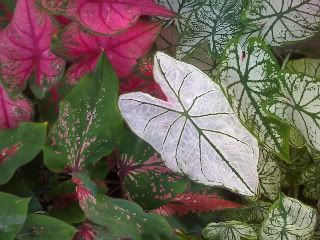
Caladiums are pretty easy to care for, once they have been established. They enjoy warm temperatures and should be kept away from drafty areas. Avoid placing these plants near air conditioners or vents, for example. If they are exposed to extreme alternating temperatures, the leaves will die.
They do not like direct sunlight, although bright shade is appreciated. Deeper shade will produce more green coloration on the leaves as opposed to the reds, whites or pinks. Placing them a few feet from a window that has a sheer curtain is a good idea, or you can move them further into the room. If your caladium is receiving too much sun you will see crisp brown patches on the leaves.
Caladiums prefer to be kept evenly moist, never drying out and never sitting in water. If you would like to fertilize your caladium, a weak feeding at every other watering will be fine. Be sure to water with tepid water, as cold tap water can give your plant a shock. Caladiums also enjoy humidity, and appreciate humidity trays or an occasional light misting.
Propagation of caladiums is usually done by division of the tubers at the end of the growing season. Check to be sure each portion of the tuber has a few buds on it. The tubers should be stored cool and dry. A basement or garage will work for most people. You should try to keep the tubers between 55 and 60 degrees Fahrenheit for the winter. Be aware that temperatures much below 50F will kill the tubers.
If you do not intend to divide or propagate from your plant, you can always leave it in it’s container for the winter. When the leaves begin to die back at the end of the season, reduce watering until you can totally withhold all water. At this time you can store the entire container in a cool, dry place until spring.
When spring has arrived, you can replant your caladium tubers. Try to plant them so that the buds face upward, but don’t worry if you don’t get it perfect. If you have left the tubers in a pot, slowly reintroduce water. If you have the ability to do so, bottom-heating is beneficial to budding caladiums.
Caladiums are a pretty punch of color for sunless areas of the home and are so easy to care for. If you have the patience to provide a dormancy period for your houseplants, caladiums will reward you for it. If not, you can always get a new variety every year and treat it as an annual houseplant. Either way, it will make a lovely specimen plant.


